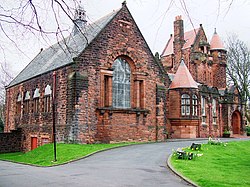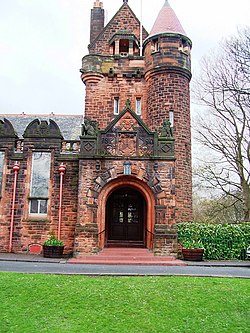Pollokshields Burgh Hall
| Pollokshields Burgh Hall | |
|
Renfrewshire | |
|---|---|
 Pollokshields Burgh Hall | |
| Type: | Town hall |
| Location | |
| Location: | 55°50’20"N, 4°17’13"W |
| History | |
| Address: | 70 Glencairn Dr, Glasgow G41 4LL |
| Built 1890 | |
| For: | Corporation of Pollokshields by Henry Edward Clifford |
| Town hall | |
| Scottish Baronial | |
| Information | |
| Website: | pollokshieldsburghhall.com |
The Pollokshields Burgh Hall stands at the edge of Maxwell Park, in the Glasgow suburb of Pollokshields. Designed by Henry Edward Clifford[1] and constructed in 17th-century Scottish Baronial style, this was opened in 1890 by Sir John Stirling Maxwell as a Masonic Meeting Place and for the use of the community but served the burgh of Pollokshields only until 1891 when the rapidly expanding city swallowed up the area. The hall contained various council offices and a courtroom. It continues to this day as a Masonic meeting place, hence the numerous Masonic symbols in the carvings (especially at the back of the building) and in the stained-glass windows.
The first lodge to meet there was Pollok No 772[2] on 25 October 1890. On that occasion the Foundation Stone was laid in the vestibule by Bro. Sir John Stirling Maxwell of Pollok, Bart., who with others were made Honorary Affiliates. Sir John donated the land for Maxwell Park and the Burgh Halls in 1888. On giving the Hall into the hands of Glasgow Corporation, a codicil was added, agreed and signed by both parties, stating that Lodge Pollok No 772 were to be always permitted to hold their meetings therein. Despite this document's apparent disappearance, it was presented to Glasgow Corporation at a time when they wanted to close it, saying it was surplus to requirements. This document saved the halls.
The hall is built of dark red sandstone from Ballochmyle in Ayrshire, which contrasts quite starkly with the blond sandstone used to build many of the surrounding villas.
The Maxwell family coat of arms is carved above the entrance porch of the Hall, flanked by two Scottish lions; and recorded in marble in the vestibule floor. The dominant external feature of the building is the 60-ft-high tower, housing a turret stair, corbelled balcony and vigil windows. To the left of the hall is the Lodge House comprising two flats, originally for the Burgh Sanitary Inspector and the Park Gardener.

In 1938 the back of the building was enlarged but with the loss of the end gallery in the large hall. By 1975 it was being used by the Social Work Department of Strathclyde Council as an occupational day centre. In 1982 it was declared surplus to requirements and for sale on the open market. After local protest, a charitable trust was formed to ensure that the building would continue to serve the public. The Pollokshields Burgh Hall Trust Ltd [3] acquired the building for £1 with missives being concluded in 1986. Only in 1991 was the title transferred with the condition that the derelict lodge house be restored within five years. With the support of generous funding from Historic Scotland, the Heritage Lottery Fund, Glasgow City Council, the Glasgow Development Agency and the local community, the lodge house and the ground floor of the Hall were completely restored and reopened in 1997. The lower ground floor has since attracted further funding and what was once little more than cellar space has been converted into an inspired, magnificent and contemporary conference or function amenity, with its own catering facilities, directly accessed through the rear loggia which opens on to Maxwell Park.
Pollokshields Burgh Hall continues to cater for business, weddings, family functions, meetings and mini conferences. This magnificent 19th-century building continues in the 21st century to provide the services for which it was originally designed.
References
- ↑ "DSA Building/Design Report". Dictionary of Scottish Architects. 2006. http://www.scottisharchitects.org.uk/building_full.php?id=201062. Retrieved 2010-07-28.
- ↑ Lodge Pollok, Pollokshields No 772
- ↑ The Pollokshields Burgh Hall Trust Ltd